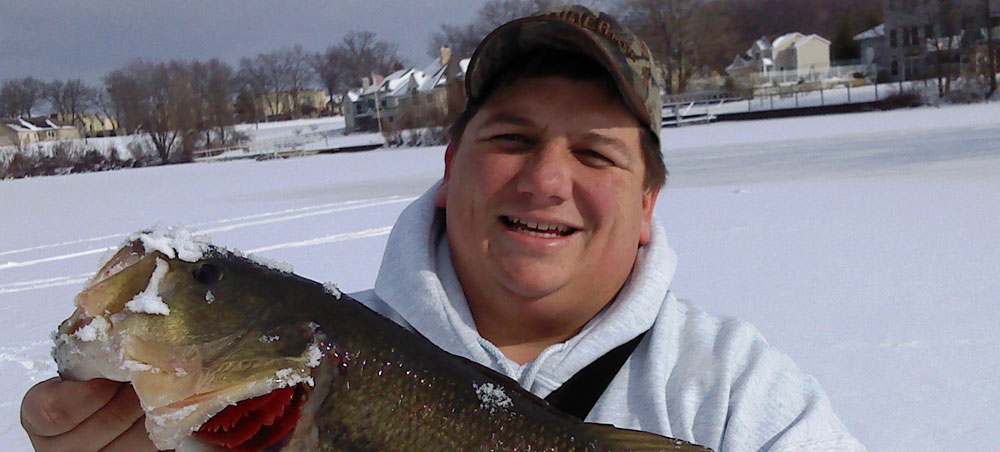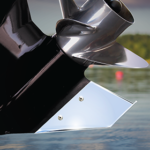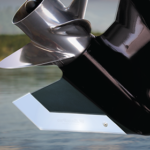Broken Ice: Ice Fishing Safety Tips
A few years back, the area known as Michiana (Indiana and Michigan border) almost lost an iconic figure. Owner of D’s Lures and competitive bass angler, Mark Fennell, took a dip in some very cold water and nearly didn’t get out. He had taken a trip to chase bluegill through the ice on a small 40-acre lake near Orland, Indiana, and took an unexpected dip. Ice fishing safety is no joke, and it’s why we’re talking about it today.
Ice Fishing Safety: Falling Through the Ice
When Fennel fell through the ice, it was not a careless mistake made by an inexperienced, overzealous ice angler. Fennell has a habit of taking safety precautions for year. “I checked out the ice the night before. I walked about 50 yards out and was confident it would be safe after another night of freezing temperatures.”
When he arrived at 8 am it was just 13 degrees. He saw six other anglers already on the ice, which further backed up his instincts.
“I crossed 300 yards of the lake and purposely avoided any snow on the ice,” recalls Fennell. “Finally, I got to the area where the other six guys were camped and began drilling some holes.” On his third hole, “The floor fell out from underneath.” There were no warnings – not a crack, or sound to suggest danger. He fell straight down like an anchor into eight feet of water.

Ice Fishing Safety: Getting Out of the Water
Fennell may be telling his story today only because of his quick reflexes. As he was going through, he tossed his auger to the side and caught the ice with his hands preventing him from going head under. “My first thought was,” he recounts, “Keep calm. It is too deep for my feet to touch. I’m only at my waist. I can get myself out.”
He quickly devised a plan to get out while remaining calm. “I determined I could push myself out by kicking my feet to make myself parallel and essentially do a push up with my arms.” Problems persisted though. He attempted this five times, and five times the ice broke further. All he really accomplished was to enlarge his hole to 12 feet in diameter and soak himself up to his armpits. The saturated clothes added tremendous weight. Fatigue became a factor. Fennell, a husband and father of two, admits, “At this time I was so tired, I was tempted to relax, but I knew if I did, I would likely go under and not come back up.” He added, “It was important to get out soon.”
Finally help arrived. Four of the other anglers came to help. One of them held out an auger to Fennell dangerously close to the open water while the three others locked arms to anchor them in place. Still, more problems persisted, “They pulled at least five times, but they could not pull me out. My parka and stomach would get stuck on the ice’s edge.” Instead of panicking, he changed tactics, “I knew I had to try something different. So, I did only what I can call an alligator roll as they pulled, and out I came.”
Ice Fishing Safety: Freezing Cold
Although the main battle was over, another obstacle remained: hypothermia. Soaking wet clothes in 13-degrees will zap out any heat instantly. Plus, Fennell’s clothes had begun to freeze almost instantly. He had to get warm, and the closest heat source was his vehicle a hundred yards away.
“It took me 15 minutes to get to my truck,” he recounted. “By then, my clothes were frozen solid. Then I reached for my keys only to find the zipper completely frozen.” With numb fingers, it took several more minutes to reach his keys. Once he did, he stripped off the frozen clothes and cranked the heat up in his truck. His fishing day was done, but he survived to fish another day.

A History of Ice Fishing Safety Tips
It is important for all ice anglers to learn from this event. Fennell is not a rookie on the ice. He is an experienced outdoorsman who has been ice fishing for over 30 years. He hunts for waterfowl and deer, competes in bass tournaments from March to November, and runs his own Wednesday night fishing circuit.
Mark first learned how to ice fish when he was just seven years old from his mom and dad. They did not share the same passion he did, so by the time he was eight, he was dragging his sled and auger to two nearby ponds all by himself.
Ironically, he recalls, “I always had a few friends ask me, ‘What if you fall in?’ I guess now I know how to answer them.”
This is a reminder of the vulnerability ice fishermen put themselves in whenever venturing on the ice.
Ice Fishing Safety Tips
Most of Fennell’s knowledge has come from his abundant experience. To say he is a seasoned ice angler would be an understatement. When the ice arrives, Fennell finds himself on it at least three times a week. With that in mind, he learned January 2, 2013 that experience does not replace good judgment. He shares, “I have learned that if we have a hard freeze for three days, the ice would be two inches thick and safe. I also have learned that snow cover changes that.” For novice ice anglers, snow works as insulation and weakens or even diminishes ice under it.
As a testament, before that day, he had never even seen an angler fall through the ice. He admits, it was his disregard of personal experiences that led to this plunge. His third hole was over snow. The ice here was just one and a half inches thick while the surrounding ice was three inches.
He also failed to bring a spud bar, which he admits was a mistake. A spud bar is used to test the strength of ice while walking on it, and you should always have one on early ice. Slamming it on the ice in front while walking will show weak spots. If it goes through the ice, turn around immediately. This old tool has sent Fennell home many times before ever drilling a hole.
This experience was a hard lesson for Fennell, but also for others, “I know what I’m doing on the ice. It has always been a practice of mine to check ice thoroughly beforehand, and I thought I had this time. But obviously, I am not above bad spots.” He admits, “I know that snow covered ice never freezes as fast, yet, I disregarded that. Because there were other anglers on the ice, and I had checked it out the night before, I just got lazy.” Fennell also adds, “I learned it does not matter how many people are on the water or what they say. You should always take proper precautions.” All ice anglers should pay heed.

How to Stay Safe on the Ice
Every year a handful of people lose their lives falling through the ice. Always proceed with extreme caution. When uncertain, use a spud bar and follow these guidelines:
* Slush is a danger sign. Avoid it completely.
* Let others know when and where you’ll be ice fishing. Avoid solitary exploits and locations.
* Bring a cell phone.
* As discussed in “5 Common Sense Boat Safety Tips That Could Safe a Life,” do not mix alcohol with ice fishing. Not only can it delay reactions and decision making, but it increases the odds of hypothermia. Most deaths are not the result of drowning; rather hypothermia is the culprit.
* When possible, pay close attention to the color of the ice. Dark and porous colors indicate soft ice whereas blue and clear colors are evidence of hard ice.
* Carry a pair of ice picks. In the event of falling in, these will dig into the ice to help crawl to safety. Keep them handy in a pocket or around neck.
Most experts agree on the following chart; however, do not forget the lesson Fennell learned. Not only will snow diminish ice thickness, other factors may exist such as current, underwater springs, and heat from shoreline. Ice does not develop uniformly: thickness can vary by inches from one area to the next.
Ice Fishing Safety Guidelines
Thickness of Ice (inches) Load or Activity
<1.75 inches of ice: STAY OFF!
2 inches of ice: One adult
4 inches of ice: * Snowmobile or smaller ATV * Groups walking in single file line
8-12 inches of ice: Small car
12-15 inches of ice: Truck
Two inches of solid, clear ice will hold an adult, but it is exceptionally risky. As with Fennell, any slight variation making it skinnier can be disastrous. Cautious ice anglers will walk on nothing skinnier than four inches.
This goes beyond protecting your boat; this is a matter of protecting your life and the people you love. Before venturing out on the ice or the water this spring, remember that tragedy can strike anyone of us regardless of experience. Now go catch a big one!







Comments